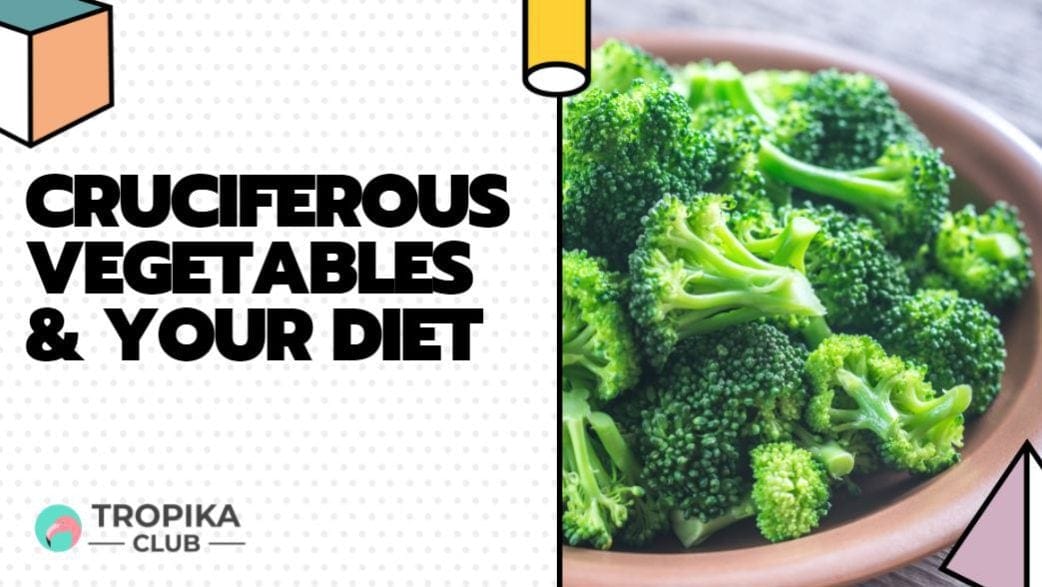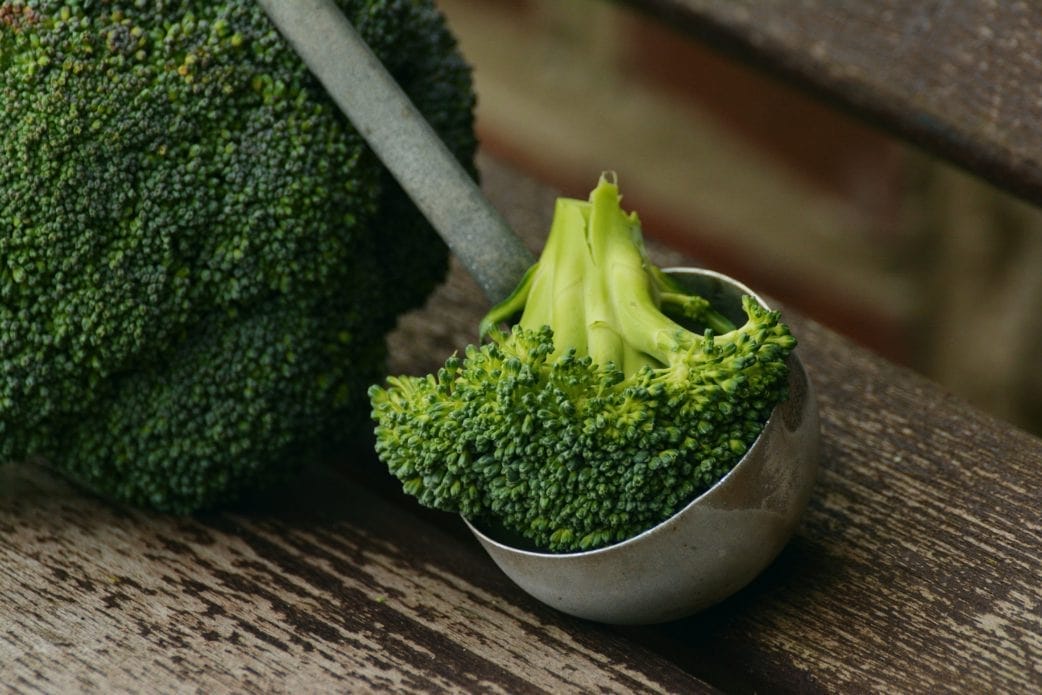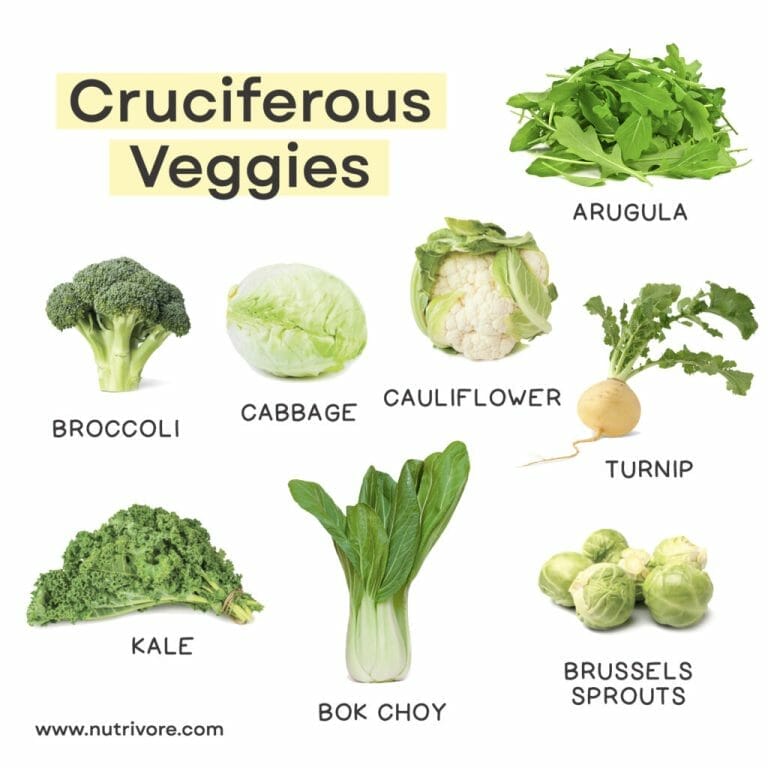Cruciferous Vegetables & Your Diet

It’s every Nutritionist’s mantra, “Eat more broccoli”. Touted for its health-promoting benefits and a reduction of chronic diseases, broccoli and its breakdown constituent sulforaphane have been studied immensely as being “plant medicine”. As a Nutritionist, Biowhole Nutrition’s Puja Bansal, is constantly recommending her clients to eat vegetables that have a multifold effect on the body, and cruciferous vegetables fit the bill. In today’s article, we delve deeper into the world of cruciferous vegetables, discussing what exactly they are, some of their incredible health benefits, as well as some of Puja’s tasty tips to incorporate more of them into your diet! The Tropika Club are certainly chowing down our greens from now on.
Table of Contents
No Time to Read? Here’s a Snappy Summary of This Article
- What are cruciferous vegetables and why are they good for you? Cruciferous vegetables are a group of plants that belong to the Brassicaceae family, which includes broccoli, cauliflower, cabbage, kale, Brussels sprouts, and more1. They are rich in antioxidants, phytochemicals, vitamins, minerals, and fiber, which can help prevent chronic diseases such as cancer, diabetes, and cardiovascular diseases1.
- How does sulforaphane work in the body? Sulforaphane is a compound that is formed when cruciferous vegetables are chopped, chewed, or cooked1. It activates a pathway called Nrf2, which regulates the expression of genes that are involved in detoxification, inflammation, and cellular protection1. Sulforaphane also modulates the gut microbiome, which plays a role in immune function and metabolic health1.
- How much cruciferous vegetables should you eat and how to prepare them? The recommended intake of cruciferous vegetables is at least 2.5 cups per week1. However, some people may experience digestive discomfort or thyroid issues from eating too much of them1. To maximize the benefits of cruciferous vegetables, it is best to consume them raw or lightly cooked, as overcooking can destroy the enzymes that produce sulforaphane1. You can also add mustard seeds, horseradish, or wasabi to enhance the formation of sulforaphane1.
- What are some delicious recipes that use cruciferous vegetables? There are many ways to enjoy cruciferous vegetables in your diet. You can make salads, soups, stir-fries, casseroles, or smoothies with them1. Some examples of tasty recipes are broccoli and cheese soup, roasted cauliflower with garlic and parmesan, kale and quinoa salad with lemon dressing, Brussels sprouts and bacon hash, and green detox smoothie1. You can find more recipes on Tropika Club Magazine’s website2.
1. What are cruciferous vegetables?
Cruciferous or Brassica vegetables originate from a family of plants known as Cruciferae and have been an important part of the human diet worldwide. The commonly consumed cruciferous vegetables include broccoli, brussel sprouts, cabbage, cauliflower, collard greens, kale, kohlrabi, mustard, rutabaga, turnips, bok choy, horseradish, watercress, wasabi, and swiss chard.

2. The incredible health benefits of cruciferous vegetables
Cruciferous vegetables are unique in that they are a rich source of sulfur-containing compounds known as glucosinolates, of which the most widely reviewed is glucoraphanin. These glucosinolates are converted into naturally occurring molecules called isothiocyanates through the action of an enzyme present in the plant tissue itself and are activated when the plant is crushed, chopped, or chewed. Our gut microbiomes also contain the enzyme myrosinase, which leads to the notion that humans were designed to get the precursor glucoraphanin and the vital components that come with eating these strong pungent flavors. Of these isothiocyanates, sulforaphane from broccoli and broccoli sprouts has been studied immensely for its ability to act as “green chemoprevention”.
Not all cruciferous vegetables contain sulforaphane, however, all of them contain isothiocyanates which are extremely effective blockers of carcinogens, a substance capable of causing cancer and increase the rate of detoxification. There are many factors that can affect the bioavailability of the bioactive compound sulforaphane, including the cooking and the co-ingestion of other substances, but research suggests that light steaming for about 3-4 minutes is the ideal methodology to keep the enzyme myrosinase intact for the conversion of glucoraphanin to sulforaphane.
3. Say Hello to Broccoli
Broccoli and other cruciferous vegetables contain vitamin A, vitamin E, and vitamin C, all of which are well-known antioxidants. Additionally, broccoli contains a whole array of B-vitamins including folic acid, which is imperative for DNA repair enzymes, along with Magnesium which plays a crucial role in energy production and bone development. Vitamin K, another nutrient found in Broccoli, is essential for helping blood clot to prevent excessive bleeding, and also for keeping our bones healthy.
Consuming a fiber-rich diet is also linked to increased protective mechanisms against diseases such as diabetes, cardiovascular disease, certain cancers, and obesity. The fiber contained within cruciferous vegetables is vital to the health of our gut microbiome and promotes the growth of our beneficial bacteria. These gut microbes feed off these fibers and multiply in number which is vital to ward off the pathogenic bacteria and to keep our gut lining intact, which is our first line of defense against the bad guys.
Sulforaphane, especially from broccoli sprouts has shown to be effective in the treatment of Autism Spectrum Disorder (ASD). Various studies done on Autistic children show that Sulforaphane from Broccoli sprouts results in improved social and cognitive behavior, verbal communication, and cognitive function. Sulforaphane has also shown to exhibit neuroprotective effects in traumatic brain injury, Alzheimer’s disease, and Parkinson’s.
Glucoraphanin and sulforaphane induce detoxification enzymes, which protect our cells and enable the excretion of compounds through the kidneys and/or bile, ultimately ending up in our feces. Sulforaphane from broccoli sprouts has shown to assist with the detoxification of carcinogenic chemicals in foods as well as from tobacco smoke and air pollution.
4. How to enjoy cruciferous veggies
According to Puja, Cruciferous vegetables should be a staple in everyone’s diet. She recommends eating them at least 3 times a week, cycling the vegetables regularly for variety so eating them never gets mundane.
For those of you who aren’t huge fanatics of veggies, believe it or not, but incorporating more cruciferous vegetables into your diet can be enjoyable.
Here are some tasty tips from Puja:
- Try broccoli lightly steamed and drizzled with a serving of extra virgin olive oil and a good dash of salt and pepper, or brussel sprouts baked in the oven with a light drizzle of tamari
- Disguise veggies as more popular food options, like cauliflower rice, and integrate different spices such as turmeric and curry powder into it to add new flavors each time
- Add a vast array of vegetables into the food you enjoy like fried rice
- If you find the taste of cruciferous vegetables too pungent, chop them up into small pieces as you mix them into your favourite food to further mask the taste of them
The world is your horizon when it comes to experimenting with cruciferous vegetables!
Read the full article here.

Conclusion
Cruciferous vegetables are not only tasty, but also beneficial for your health. They contain a variety of nutrients and phytochemicals that can protect your cells from damage, inflammation, and oxidative stress. They can also modulate your gut microbiota, which influences your immune system and metabolism. By eating cruciferous vegetables regularly, you can lower your risk of developing chronic diseases such as cancer, diabetes, and cardiovascular diseases. You can also enjoy the diverse flavors and textures of cruciferous vegetables in different cuisines and recipes. Whether you prefer them raw or cooked, in salads or soups, in stir-fries or casseroles, you can always find a way to incorporate them into your diet. Tropika Club Magazine has some amazing recipes that use cruciferous vegetables that you can try at home. Don’t miss this opportunity to improve your health and wellness with the power of cruciferous vegetables! 😊

Frequently Asked Questions (FAQ)
Q: What are some examples of cruciferous vegetables?
A: Cruciferous vegetables are a group of plants that belong to the Brassicaceae family, which includes broccoli, cauliflower, cabbage, kale, Brussels sprouts, and more. Some other examples are arugula, bok choy, radish, turnip, watercress, and mustard greens.
Q: Why are cruciferous vegetables good for preventing cancer?
A: Cruciferous vegetables contain a compound called glucosinolate, which is converted into sulforaphane and other isothiocyanates when chopped, chewed, or cooked. These compounds can inhibit the growth and spread of cancer cells by inducing apoptosis (cell death), blocking angiogenesis (blood vessel formation), and modulating gene expression.
Q: How can I increase the formation of sulforaphane in cruciferous vegetables?
A: Sulforaphane is formed by the action of an enzyme called myrosinase, which is released when cruciferous vegetables are damaged or exposed to heat. To increase the formation of sulforaphane, you can chop or crush the vegetables before cooking them, or add a source of myrosinase such as mustard seeds, horseradish, or wasabi to the cooked vegetables.
Q: Are there any side effects or risks of eating too much cruciferous vegetables?
A: Cruciferous vegetables are generally safe and healthy to eat, but some people may experience digestive discomfort or gas from eating too much of them. This is because they contain a type of sugar called raffinose, which can cause bloating and flatulence in some people. To reduce this effect, you can cook the vegetables well or take digestive enzymes before eating them. Another potential risk of eating too much cruciferous vegetables is that they can interfere with thyroid function in some people who have iodine deficiency or thyroid disorders. This is because they contain a substance called goitrogen, which can inhibit the uptake of iodine by the thyroid gland and cause goiter (enlargement of the thyroid) or hypothyroidism (low thyroid hormone levels). To prevent this problem, you should consume adequate amounts of iodine from other sources such as iodized salt, seafood, dairy products, or supplements. You should also consult your doctor before eating large amounts of cruciferous vegetables if you have any thyroid issues.

Have a Place to Recommend?
Your contribution is valuable to us! Are there any outstanding businesses that you believe should be added to our list? If so, please send your recommendations to us at [email protected]. Tropika Club will review your suggestions and update the list accordingly. Thank you for your help in making our list of businesses as comprehensive and accurate as possible.
Meanwhile, Check out Tropika Club’s Ecosystem of Websites

Tropika Club Magazine – Tropika Club Magazine is a Singapore-based publication that features articles on a wide range of topics with a focus on local businesses and content for the region. The magazine emphasizes supporting local businesses through its #SupportLocal initiative, which includes coverage of everything from neighborhood hawker stalls to aesthetic clinics in town. In addition to highlighting local businesses, Tropika Club Magazine also covers a variety of local content, including beauty, lifestyle, places, eats, and what’s on in Singapore and the Asia Pacific region.
Tropika Club Deals – Tropika Club Deals is a leading online deals and voucher shopping site in Singapore, offering amazing discounts on beauty, wellness, and fitness products and services. It’s the perfect platform for customers who want to discover the best deals without having to commit to a specific appointment date and time. These deals are available at major beauty stores, facial salons, hair salons, and other brands in Singapore, with no minimum spend required. Choose from guaranteed discounted deals in the categories of hairstyling, hair removal, facial & aesthetics, body slimming, brows & lashes, nails & makeup, massage & spa or fitness & wellness. Tropika Club Deals is also ideal for customers who want to buy vouchers as gifts or to use for the future. So whether you’re looking to save money on your next haircut or want to treat yourself to a relaxing massage, Tropika Club Deals has got you covered with the best voucher and coupon deals in Singapore!




